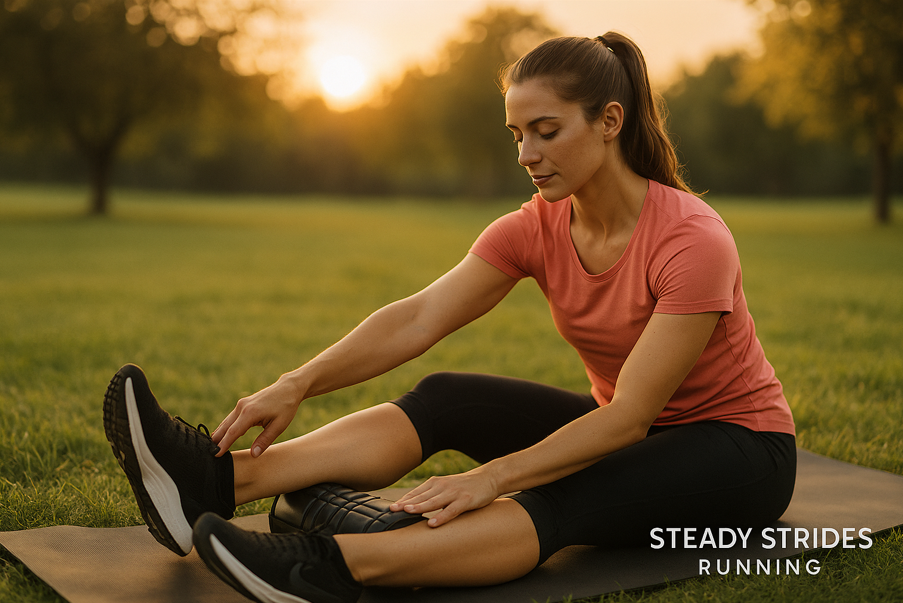Recovery is one of the most important — yet most overlooked — parts of any training plan. Whether you’re a beginner runner or have miles under your belt, learning how to recover after a run is essential for avoiding injury and making consistent progress.
Let’s dive into why post-run recovery matters and the best tools and strategies to support your running journey.
💪 Why Recovery Matters for Runners
When you run, your muscles experience microtears — tiny stresses that your body needs to repair in order to grow stronger. That repair process happens during recovery. Skipping rest means your body doesn’t get the chance to rebuild, increasing your risk for:
- Overuse injuries like shin splints, tendinitis, and stress fractures
- Hormonal imbalances, especially with cortisol (your stress hormone)
- Weakened immune function
- Plateaued performance
So even though it might feel like downtime, rest is when your body actually gets faster and more efficient.
🛌 Prioritize Sleep and Listen to Your Body
Sleep is your secret weapon for recovery. Aim for 7–9 hours a night, especially after longer or harder runs. Also, tune into how your body feels — if you’re unusually fatigued or sore, it’s okay to move or skip a run.
📌 Tip: Build rest days into your weekly plan and don’t feel guilty about using them!
🦊 Cool Down and Stretch After Every Run
Start your recovery immediately after your workout:
- Cool down: Walk for 5–10 minutes to bring your heart rate down gradually
- Stretch: Focus on your quads, hamstrings, calves, and hips using gentle static stretches or dynamic mobility work
👉 Check out Best Stretches for Successful Runners to see what I use after runs.
🥗 Nutrition for Recovery: What to Eat After a Run
What you eat post-run helps replenish glycogen, repair muscles, and rehydrate your system. Try to refuel within 30–60 minutes:
- Carb + protein combos: Banana with peanut butter, Greek yogurt and berries, or a protein shake
- Hydration: Don’t forget to replace fluids and electrolytes — especially after a sweaty session
My favorite combo? A vanilla protein shake with a horchata electrolyte packet — delicious and functional! Here are my favorites if you want to give it a try for yourself.


🧸 Recovery Tools That Actually Help
There are plenty of affordable tools you can use at home to ease soreness and prevent tightness:
- Foam rollers & massage balls: Great for releasing tension and boosting circulation
- Compression gear: Try socks or compression boots to reduce inflammation (especially helpful if you’re battling shin splints)
- Epsom salt baths: Soak for 15–20 minutes in warm water with 1–2 cups of Epsom salt to ease muscles and promote relaxation
Bonus tip: Warm baths or hot tubs can also lower cortisol and improve sleep.
Here is the foam roller I use (it comes in different colors)

Here is the massage tool that I use. I like that it comes with different attachments.

Here is the Epsom salt that I like to use.

🔥 Heat vs. Ice: Which Should You Use?
- Heating pads: Best for stiffness or chronic tightness (like sore hamstrings or lower back). Use before stretching to warm up muscles.
- Cold packs: Best for acute pain or inflammation (like a sore knee). They help reduce swelling and soothe sharp discomfort.
I love a large wraparound ice pack for knees, and this mini ice roller ball is perfect for targeting tight muscles.
Here is a large ice pack that I like because it is large enough to wrap around my leg.


Lastly, this little ice roller ball is great for releasing any muscle tension.

💡 Final Thoughts: Make Recovery Part of Your Running Routine
I didn’t take recovery seriously when I first started running — and I paid for it with injuries and burnout. But once I started making rest, sleep, and recovery tools a priority, I noticed big improvements in how I felt and performed.
Remember, recovery looks different for everyone and can change day to day. Having the right tools and knowledge will help you stay consistent and injury-free. Let me know in the comments if you have a favorite recovery method that I missed. I would love to try it.
✨ Happy running!
As always, run steady and run strong—your journey is just beginning. Until next time!
This post includes affiliate links. I earn a small commission if you buy through them, at no extra cost to you.


Leave a Reply